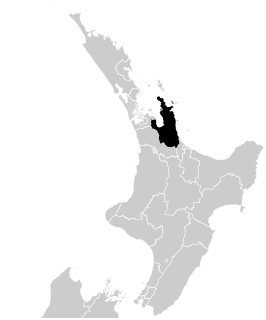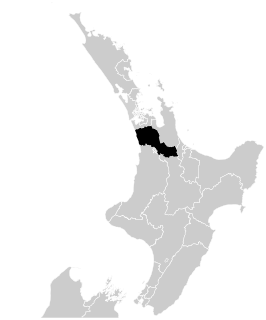Related Research Articles

The 1899 New Zealand general election was held on 6 and 19 December in the European and Māori electorates, respectively, to elect 74 MPs to the 14th session of the New Zealand Parliament. The election was again won by the Liberal Party, and Richard Seddon remained Prime Minister.

Coromandel is a New Zealand electoral division returning one member to the House of Representatives. It is currently represented by Scott Simpson, a member of the National Party.
Piako was a New Zealand parliamentary electorate established in 1946 and disestablished in 2008. It was last held by Lindsay Tisch MP from 2002 to 2008.

Waikato is an electorate in the New Zealand Parliament. A Waikato electorate was first created in 1871 and an electorate by this name has existed from 1871 to 1963, 1969 to 1996, and 2008 to the present, though exact borders have often changed.
Waipa is a former parliamentary electorate in the Waikato region of New Zealand, which existed for various periods between 1876 and 1996.
Taranaki was a New Zealand parliamentary electorate that existed for three periods between 1881 and 1996. It was represented by nine Members of Parliament.
Waitemata was a New Zealand parliamentary electorate, from 1871 to 1946, and then from 1954 to 1978. It was represented by 18 members of parliament.
Pahiatua is a former New Zealand parliamentary electorate in the Wairarapa region. It existed from 1896 to 1996, and was represented by nine Members of Parliament, including Prime Minister Keith Holyoake for 34 years.
Waiapu was a New Zealand parliamentary electorate in the Gisborne – East Coast Region of New Zealand, from 1893 to 1908.
Buller is a former New Zealand parliamentary electorate, from 1871 to 1972. It was represented by eleven Members of Parliament.
Tuapeka is a former parliamentary electorate in the Otago region of New Zealand, from 1871 to 1911.
Wakatipu was a parliamentary electorate in the Otago region of New Zealand, from 1871 to 1928.
Geraldine was a former parliamentary electorate in the South Canterbury region of New Zealand that existed three times from 1875 to 1911. It was represented by six Members of Parliament.
Mataura was a parliamentary electorate in the Southland Region of New Zealand, from 1866 to 1946.
Westland was a parliamentary electorate in the West Coast of New Zealand from 1866 to 1868 and 1890 to 1972. In 1972 the Tasman and West Coast electorates replaced the former Buller and Westland electorates.
Wellington Suburbs was a parliamentary electorate in Wellington, New Zealand. It existed from 1893 to 1902, then from 1908 to 1911, and from 1919 to 1946. The electorate was represented by six Members of Parliament.
Te Aroha was a parliamentary electorate in the Waikato region of New Zealand from 1890 to 1893. The electorate was represented by two Members of Parliament. The current Te Aroha ward is represented by the Matamata-Piako District in the Waikato region of New Zealand.
Ellesmere was a parliamentary electorate in the Canterbury region of New Zealand. It existed for two periods between 1861 and 1928 and was represented by six Members of Parliament.
Waimea-Sounds was a fully rural parliamentary electorate in the Marlborough and Nelson Regions of New Zealand, from 1893 to 1896. During its one parliamentary term of existence, the Waimea-Sounds electorate was represented by one Member of Parliament.
Hawera was a parliamentary electorate in the South Taranaki District of New Zealand from 1896 to 1908. It was represented by two Members of Parliament over the four parliamentary terms of its existence.
References
- McRobie, Alan (1989). Electoral Atlas of New Zealand. Wellington: GP Books. ISBN 0-477-01384-8.
- Wilson, James Oakley (1985) [First published in 1913]. New Zealand Parliamentary Record, 1840–1984 (4th ed.). Wellington: V.R. Ward, Govt. Printer. OCLC 154283103.